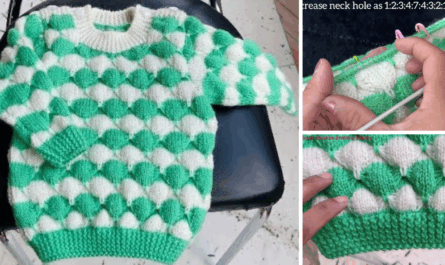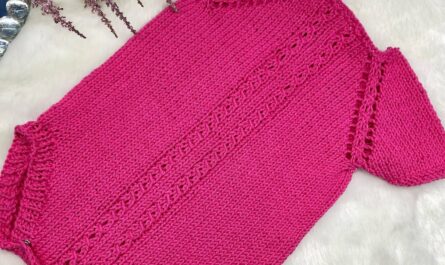Imagine the cozy comfort of a hand-knitted dress, elevated by the exquisite beauty of needlework. An embroidered knitted sweater frock is precisely this – a delightful fusion of two beloved fiber arts, resulting in a garment that is utterly unique, deeply personal, and a true work of wearable art. It’s a statement piece that blends warmth and comfort with artistic expression, allowing your creativity to shine in every stitch, both knitted and embroidered.
This detailed article will guide you through the captivating process of creating an embroidered knitted sweater frock, from selecting your base to designing and executing your needlework masterpiece.
Why Create an Embroidered Knitted Sweater Frock?
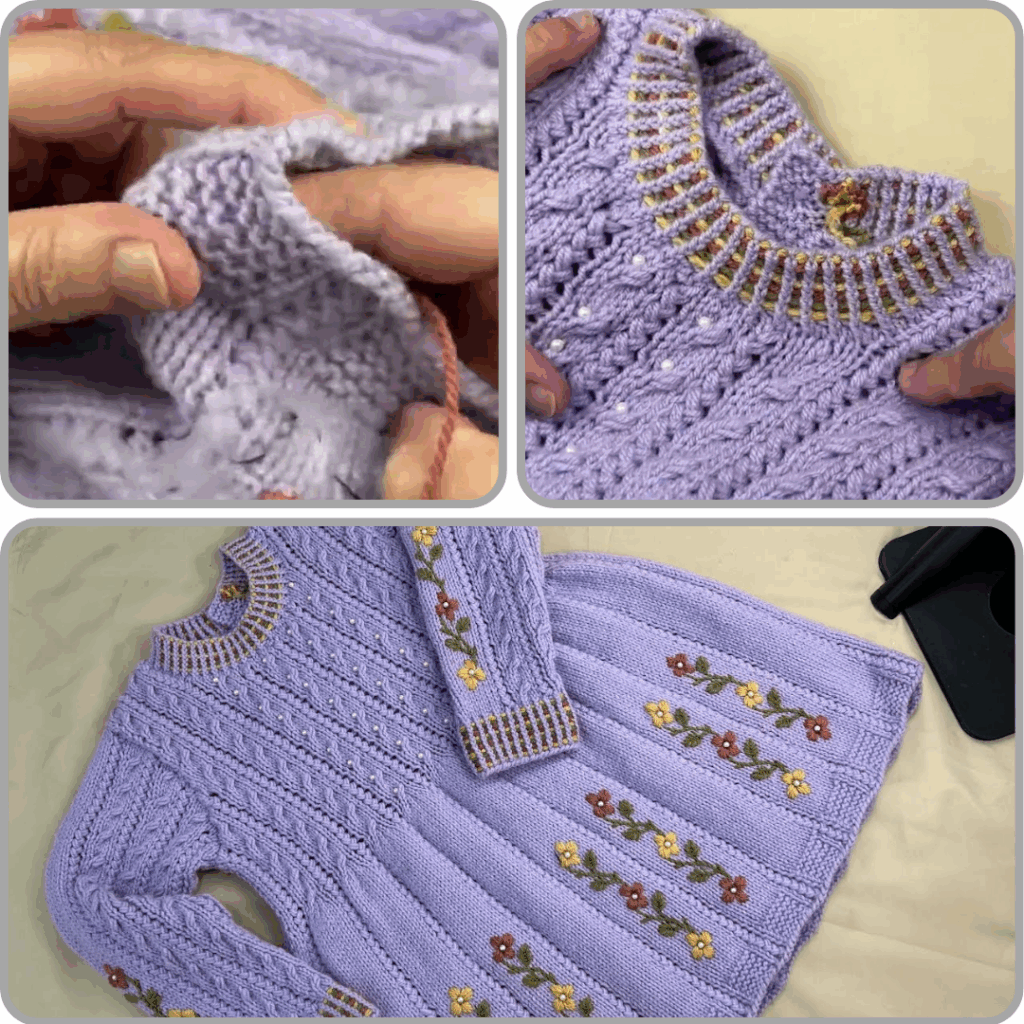
- A Unique Masterpiece: This combination of crafts produces a one-of-a-kind garment that stands out from both mass-produced clothing and purely knitted items.
- Deeply Personal Expression: Choose your favorite knit stitch patterns, yarn colors, and then layer on embroidery designs that reflect your personality, interests, or a specific mood.
- Custom Fit & Style: You control every aspect, from the exact fit of the knitted frock to the placement and intensity of the embroidery, ensuring it flatters and delights.
- Sustainable & Mindful Crafting: Breathe new life into a simple knitted dress, elevate a plain store-bought knit, or give a beloved handmade garment an artistic facelift.
- Heirloom Potential: A garment crafted with such care and artistic detail is destined to become a cherished heirloom, passed down through generations.
Understanding the “Sweater Frock” Base:
The foundation of your embroidered creation is a knitted dress or a long, tunic-length sweater that functions as a dress.
- Silhouettes:
- A-line: Gently flares from the bust or hips, offering a flattering and comfortable fit.
- Straight/Column: A simple, relaxed fit that falls straight down for a minimalist look.
- Tiered Skirt: A fitted bodice transitions into a fuller, often gathered, skirt section, creating a whimsical and romantic silhouette.
- Oversized Sweater Dress: A relaxed, often slouchy fit with dropped shoulders, prioritizing comfort and contemporary style.
- Yarn Considerations for the Knit Base:

- Fiber:
- Wool (Merino, Alpaca, Cashmere, Blends): Excellent choices for softness, warmth, elasticity, and beautiful drape. They hold their shape well and are easy to embroider.
- Cotton or Linen Blends: Great for lighter-weight versions suitable for transitional seasons, offering breathability and a lovely texture.
- Weight: DK (Double Knitting), Worsted, or Chunky weights are generally ideal. They provide a good canvas for embroidery – not too loose (which can distort stitches) and not too dense (which can make it hard to pierce).
- Gauge: Aim for consistent, even stitches. A fabric that is too loose or too tight can make embroidery more challenging or prone to distortion.
- Construction Methods (Briefly): Your base can be knit using various methods:
- Top-Down Seamless: (Raglan, Circular Yoke) – very popular as it avoids seaming and allows for easy length adjustment.
- Bottom-Up: Knit in pieces and seamed, or knit in the round and then shaped.
Embracing the Embroidery:
This is where your frock truly comes alive, adding texture, color, and storytelling to your knitwear.
- Why Embroider Knits?
- Texture & Dimension: Adds a tactile element that flat embroidery on woven fabric simply can’t replicate.
- Color & Pattern: Introduces intricate designs, floral motifs, abstract patterns, or vibrant color pops.
- Personalization: Make a simple knit uniquely yours.
- Elevates Simple Designs: A basic stockinette frock becomes a showstopper with thoughtful embroidery.
- Hides Minor Imperfections: Clever embroidery can camouflage a dropped stitch or uneven tension!
- Types of Embroidery on Knits:
- Surface Embroidery (Standard Embroidery): This is the most common method, where stitches are worked on top of the knitted fabric, piercing through loops.
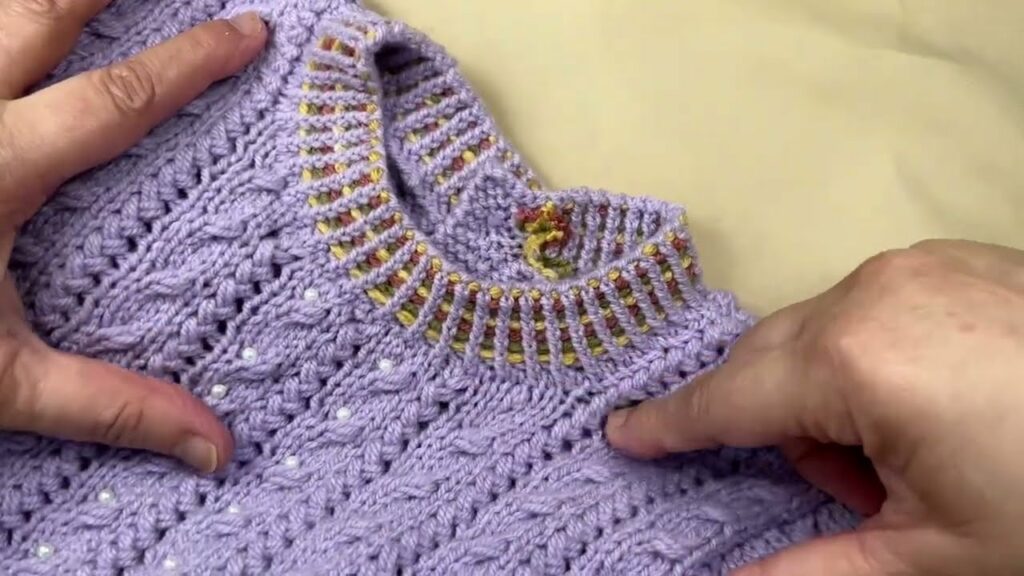
- Popular Stitches: Chain stitch (great for outlines), running stitch, backstitch, French knot (for texture), lazy daisy (for petals), woven wheel (for roses), detached chain (for leaves/petals).
- Duplicate Stitch (Knitting Embroidery): This technique mimics the V-shape of knit stitches, making the embroidered design appear as if it was knitted directly into the fabric. It’s excellent for geometric patterns, subtle colorwork, or adding small motifs like crosses or pixels.
- Swiss Darning: Similar to duplicate stitch, often used for adding small motifs or mending worn areas seamlessly.
- Crewel Embroidery: Traditionally wool threads on linen, but adapting this technique to a knitted base with wool embroidery thread creates a rich, textural, and often folk-art inspired look.
- Embroidery Yarn/Floss:
- Cotton Embroidery Floss: Versatile, comes in many colors, good for precise, detailed work.
- Wool Embroidery Yarn (Fingering/DK Weight): Ideal for matching the texture of your knit base, creating a cohesive look, and for duplicate stitch or bolder designs.
- Perle Cotton: Has a lovely sheen, durable, good for outlining or more defined elements.
- Silk Thread: Adds a luxurious touch and subtle sheen for delicate details.
- Tools for Embroidery:
- Embroidery Needle: Sharp point for piercing knit fabric. A tapestry needle (blunt point) is essential for duplicate stitch.
- Small Embroidery Hoop: Helps stabilize the knit fabric. Use carefully! Do not overtighten, as this can permanently stretch or distort the knit. Release the hoop frequently.
- Water-Soluble Marker or Tailor’s Chalk: For transferring your design.
- Small, Sharp Scissors: For snipping threads.
Designing Your Embroidered Knitted Sweater Frock:
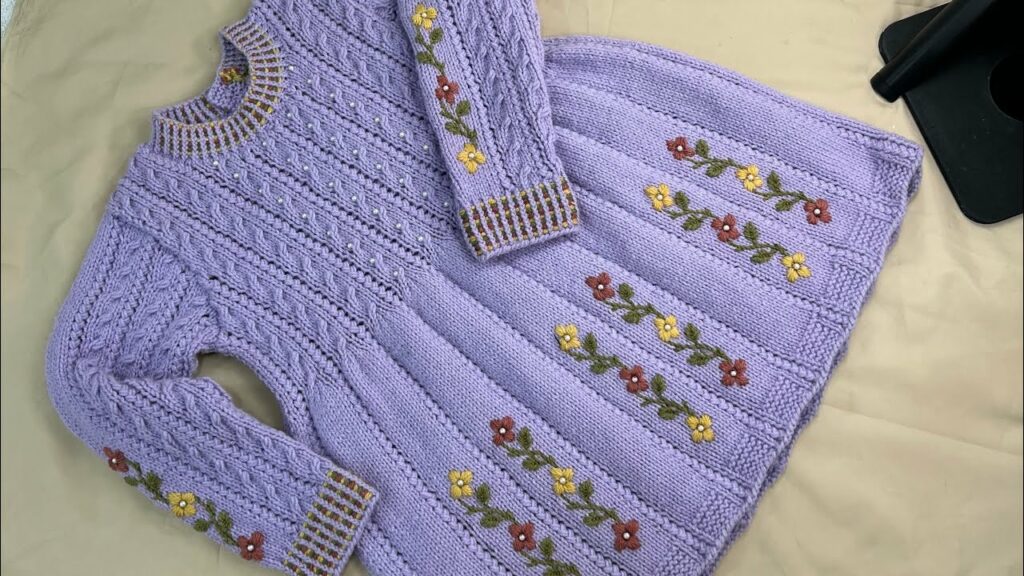
This is where your vision comes to life!
- Theme/Inspiration: Draw from nature (floral, leaves, celestial bodies), abstract shapes, geometric patterns, folk art motifs, animals, monograms, or even simple words.
- Placement Strategy:
- Yoke/Collarbone: Frames the face and draws attention upwards.
- Cuffs/Hem: Adds a delicate, finishing detail.
- Side Panels: Creates vertical interest.
- All-Over Scattered: A whimsical, random distribution of small motifs.
- Large Central Motif: Makes a bold statement on the front or back.
- Along Seams/Raglan Lines: Highlights the garment’s construction.
- Color Palette:
- Monochromatic: Different shades of one color for subtle texture and depth.
- Complementary: Colors opposite on the color wheel (e.g., blue and orange) for vibrant contrast.
- Analogous: Colors next to each other on the color wheel (e.g., blues and greens) for a harmonious blend.
- Scrappy: Use a variety of colors for a charming, folk-art inspired look.
- Balancing Knit & Embroidery:
- If your knit base has a complex stitch pattern (e.g., intricate cables or lace), opt for simpler, more minimal embroidery.
- If your knit base is a simple texture (like stockinette or garter), you can go bolder and more detailed with your embroidery.
- Ensure the embroidery yarn weight and stitches don’t overwhelm or distort the drape of your knitted fabric.
Step-by-Step Process for Embroidering Your Frock:
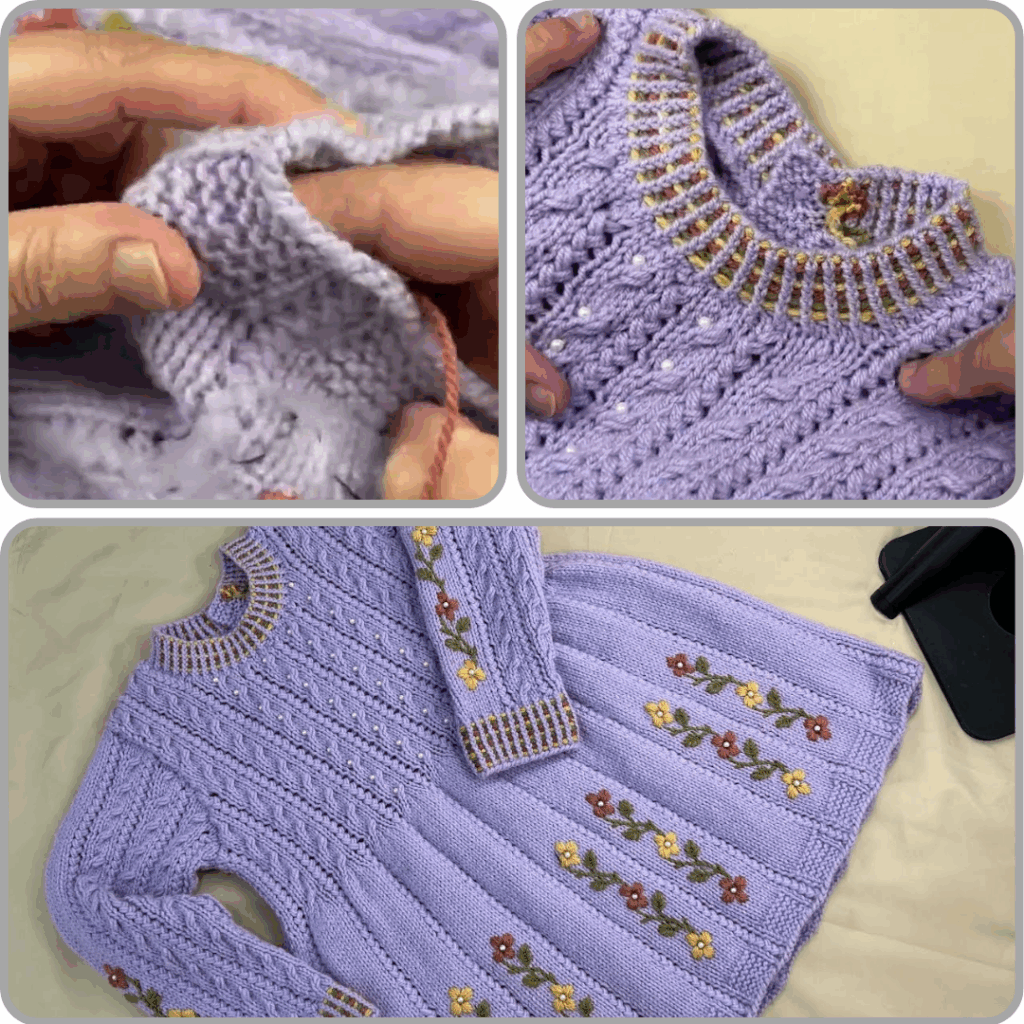
- Prepare the Frock Base:
- Knit (or select) your sweater frock. Make sure it’s fully finished.
- Crucially, wash and block your knitted frock thoroughly. This stabilizes the fabric, sets the stitches, and ensures accurate sizing before you begin embroidering. Do not skip this step!
- Design Transfer:
- Freehand: Draw your design directly onto the knit fabric using a water-soluble marker or tailor’s chalk.
- Sticky/Wash-Away Stabilizer: This is excellent for knits. Draw your design on the stabilizer, stick it to the fabric, stitch through both layers, then wash away the stabilizer.
- Tissue Paper: Draw your design on tissue paper, pin it to the fabric, stitch through both, then carefully tear away the tissue paper when done.
- Hoop (Optional but Recommended):
- Place a small embroidery hoop around the area you are working on.
- Do NOT overtighten the hoop on knit fabric, as this can stretch or distort it. Just enough tension to keep the fabric relatively flat.
- Release the hoop frequently and reposition it for new areas.
- Embroider:
- Work your chosen stitches, keeping your tension even. Avoid pulling too tightly, which can pucker the knit fabric. Avoid leaving loops too loose, which can snag.
- If working duplicate stitch, remember to follow the V-shape of the knit stitches.
- For surface embroidery, consider using a backing (like a lightweight knit interfacing or water-soluble stabilizer) if your knit is very loose or fine, to prevent distortion.
- Finishing Touches:
- Secure all your embroidery thread ends neatly on the wrong side of your work.
- Gently wash or steam (if needed) to remove any transfer markings.
- Give the entire frock a final gentle press or light blocking if necessary to set the embroidery.
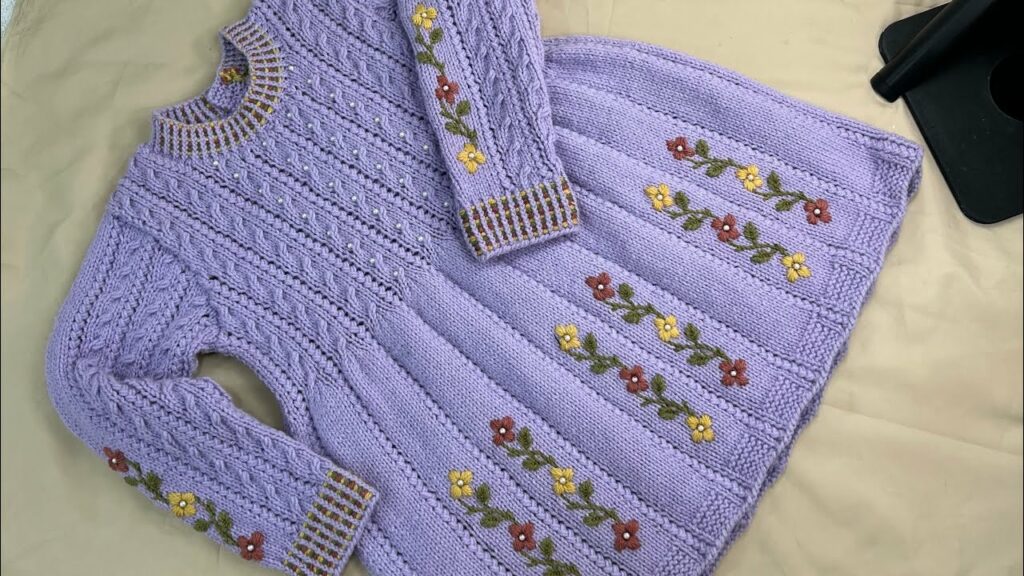
Tips for Success:
- Practice Makes Perfect: Always test your chosen embroidery stitches and thread on a swatch of your knitted fabric before working on your actual frock.
- Needle Smarts: Use a sharp-pointed embroidery needle for piercing through knitted stitches. A tapestry needle is essential for duplicate stitch.
- Stabilize When Needed: For very fine, loosely knit, or exceptionally stretchy fabrics, a temporary iron-on knit interfacing or water-soluble stabilizer can prevent distortion during embroidery.
- Even Tension is Key: This applies to both your knitting and your embroidery. Consistent tension ensures a neat, professional finish.
- Work Flat: If your frock is knit in pieces and then seamed, it’s often easier to do the embroidery before seaming the pieces together.
- Learn from Resources: Consult embroidery books or online tutorials for how to start and end stitches cleanly on the wrong side of your fabric.
- Be Patient: Embroidery is a meditative process. Enjoy the journey of bringing your vision to life, one stitch at a time.
Video Tutorial :
Creating an embroidered knitted sweater frock is a deeply satisfying project that blends the best of two beautiful crafts. The result is a truly personal, cozy, and artistic garment that will be cherished for years to come. Dive in and let your creativity flow!

